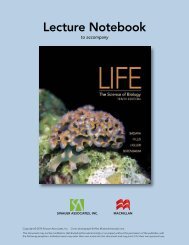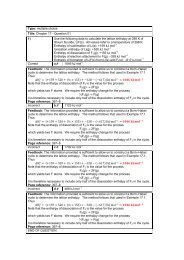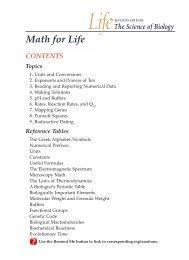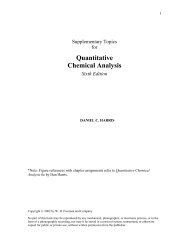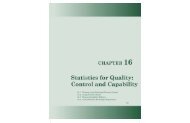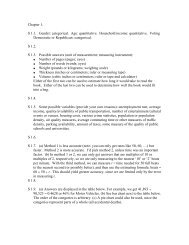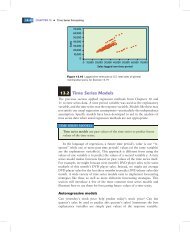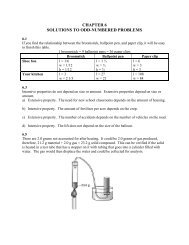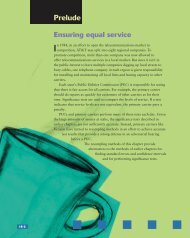SUPPLEMENTARY EXERCISES for ... - WH Freeman
SUPPLEMENTARY EXERCISES for ... - WH Freeman
SUPPLEMENTARY EXERCISES for ... - WH Freeman
- No tags were found...
You also want an ePaper? Increase the reach of your titles
YUMPU automatically turns print PDFs into web optimized ePapers that Google loves.
Chapter 45S6.15 Use the result of Exercise S6.15 to give the probabilities of Type I and Type II errors <strong>for</strong>the test discussed there. Take the alternative hypothesis to be µ = 295.S6.16 Use the result of Exercise S6.14 to give the probability of a Type I error and the probabilityof a Type II error <strong>for</strong> the test in that exercise when the alternative is µ = 460.ChapterS6.17 A study compares two groups of mothers with young children who were on welfare twoyears ago. One group attended a voluntary training program offered free of charge at a localvocational school and advertised in the local news media. The other group did not choose toattend the training program. The study finds a significant difference (P < 0.01) between theproportions of the mothers in the two groups who are still on welfare. The difference is notonly significant but quite large. The report says that with 95% confidence the percent of thenonattending group still on welfare is 21% ± 4% higher than that of the group who attended theprogram. You are on the staff of a member of Congress who is interested in the plight of welfaremothers and who asks you about the report.(a) Explain briefly and in nontechnical language what “a significant difference (P < 0.01)”means.(b) Explain clearly and briefly what “95% confidence” means.(c) Is this study good evidence that requiring job training of all welfare mothers would greatlyreduce the percent who remain on welfare <strong>for</strong> several years?S6.18 Use a computer to generate n = 5 observations from a normal distribution with mean20 and standard deviation 5—N(20, 5). Find the 95% confidence interval <strong>for</strong> µ. Repeat thisprocess 100 times and then count the number of times that the confidence interval includes thevalue µ = 20. Explain your results.S6.19 Use a computer to generate n = 5 observations from a normal distribution with mean20 and standard deviation 5—N(20, 5). Test the null hypothesis that µ = 20 using a two-sidedsignificance test. Repeat this process 100 times and then count the number of times that youreject H 0 . Explain your results.S6.20 Use the same procedure <strong>for</strong> generating data as in the previous exercise. Now test the nullhypothesis that µ = 22.5. Explain your results.S6.21 Figure 6.2 demonstrates the behavior of a confidence interval in repeated sampling byshowing the results of 25 samples from the same population. Now you will do a similar demonstration.Suppose that (unknown to the researcher) the mean SAT-M score of all Cali<strong>for</strong>nia highschool seniors is µ = 460, and that the standard deviation is known to be σ = 100. The scoresvary normally.(a) Simulate the drawing of 25 SRSs of size n = 100 from this population.(b) The 95% confidence interval <strong>for</strong> the population mean µ has the <strong>for</strong>m x ± m. What is themargin of error m? (Remember that we know σ = 100.)(c) Use your software to calculate the 95% confidence interval <strong>for</strong> µ when σ = 100 <strong>for</strong> each of



